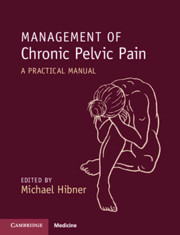Book contents
- Management of Chronic Pelvic Pain
- Management of Chronic Pelvic Pain
- Copyright page
- Contents
- Contributors
- Foreword
- Chapter 1 Introduction to Chronic Pelvic Pain
- Chapter 2 Neurobiological Basis of Pelvic Pain
- Chapter 3 History and Evaluation of Patients with Chronic Pelvic Pain
- Chapter 4 Psychological Assessment of a Female Patient with Chronic Pelvic Pain
- Chapter 5 Musculoskeletal Assessment for Patients with Pelvic Pain
- Chapter 6 Pharmacological Management of Patients with Pelvic Pain
- Chapter 7 Evidence for Surgery for Pelvic Pain
- Chapter 8 Pelvic Pain Arising from Endometriosis
- Chapter 9 Bladder Pain Syndrome
- Chapter 10 Pelvic Pain Arising from Pelvic Congestion Syndrome
- Chapter 11 Irritable Bowel Syndrome
- Chapter 12 Vulvodynia
- Chapter 13 Pelvic Pain Arising from Adhesive Disease
- Chapter 14 Pelvic Pain Arising from Ovarian Remnant Syndrome
- Chapter 15 Pudendal Neuralgia
- Chapter 16 Other Peripheral Pelvic Neuralgias
- Chapter 17 Chronic Pain After Gynecological Surgery
- Chapter 18 Pain Arising from Pelvic Mesh Implants
- Chapter 19 Treatment of Sexual Dysfunction Arising from Chronic Pelvic Pain
- Chapter 20 Physical Therapy Interventions for Musculoskeletal Impairments in Pelvic Pain
- Chapter 21 If Everything Else Fails
- Index
- References
Chapter 3 - History and Evaluation of Patients with Chronic Pelvic Pain
Published online by Cambridge University Press: 08 March 2021
- Management of Chronic Pelvic Pain
- Management of Chronic Pelvic Pain
- Copyright page
- Contents
- Contributors
- Foreword
- Chapter 1 Introduction to Chronic Pelvic Pain
- Chapter 2 Neurobiological Basis of Pelvic Pain
- Chapter 3 History and Evaluation of Patients with Chronic Pelvic Pain
- Chapter 4 Psychological Assessment of a Female Patient with Chronic Pelvic Pain
- Chapter 5 Musculoskeletal Assessment for Patients with Pelvic Pain
- Chapter 6 Pharmacological Management of Patients with Pelvic Pain
- Chapter 7 Evidence for Surgery for Pelvic Pain
- Chapter 8 Pelvic Pain Arising from Endometriosis
- Chapter 9 Bladder Pain Syndrome
- Chapter 10 Pelvic Pain Arising from Pelvic Congestion Syndrome
- Chapter 11 Irritable Bowel Syndrome
- Chapter 12 Vulvodynia
- Chapter 13 Pelvic Pain Arising from Adhesive Disease
- Chapter 14 Pelvic Pain Arising from Ovarian Remnant Syndrome
- Chapter 15 Pudendal Neuralgia
- Chapter 16 Other Peripheral Pelvic Neuralgias
- Chapter 17 Chronic Pain After Gynecological Surgery
- Chapter 18 Pain Arising from Pelvic Mesh Implants
- Chapter 19 Treatment of Sexual Dysfunction Arising from Chronic Pelvic Pain
- Chapter 20 Physical Therapy Interventions for Musculoskeletal Impairments in Pelvic Pain
- Chapter 21 If Everything Else Fails
- Index
- References
Summary
There are multiple causes of pelvic pain, and it is very important to acknowledge that in most women pelvic pain is not of gynecological origin. It is also important to remember that in most patients with pelvic pain there is more than one reason for pain and simply just treating endometriosis without addressing pelvic floor or bladder pain or associated emotional issues is not enough. History is by far the single most important part of the diagnostic process, with examination being less useful and radiological tests often not helpful at all. Three simple questions can probably diagnose most of the causes for pelvic pain: How did the pain start, what makes in better and what makes it worse? Patients whose pain began at menarche may have endometriosis, but cyclical pain does not always mean the diagnosis of endometriosis. Many pain symptoms may worsen during the menstrual period. Conversely, when pain begins after surgery or trauma to the pelvis it is almost certainly not endometriosis. Pain after delivery may be due to musculoskeletal issues (muscle spasm, nerve injury, incisional neuroma – episiotomy or laparotomy scar) but also result from congested pelvic veins. Pain that worsens with physical activity and improves with rest and use of a heating pad is almost always of musculoskeletal origin. Finally, pain with a full bladder may be consistent with interstitial cystitis/bladder pain syndrome but pain at the end of urination is often from spasm of pelvic floor muscles. Pain during intercourse is present in most of the conditions causing pelvic pain but in patients with pelvic floor muscle spasm this pain/pressure usually persists for hours to days after. Use of questionnaires such as the one developed by the International Pelvic Pain Society may be very useful to determine the cause of pain.
- Type
- Chapter
- Information
- Management of Chronic Pelvic PainA Practical Manual, pp. 13 - 22Publisher: Cambridge University PressPrint publication year: 2021



